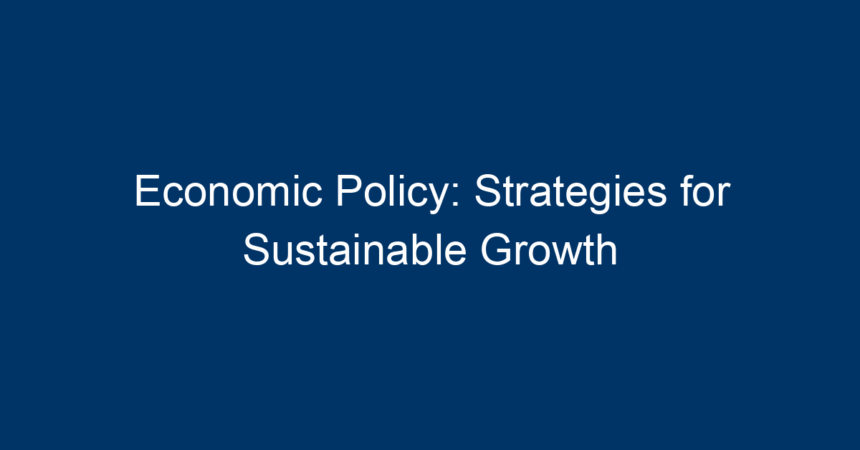In an ever-evolving global landscape, economic policy plays a pivotal role in shaping nations’ futures. It is the blueprint through which governments can foster sustainable growth, drive innovation, and ensure the equitable distribution of resources. As countries face unprecedented challenges—from climate change to economic inequality—the need for effective economic strategies has never been more pressing. In this article, we delve into economic policy, exploring various strategies that nations can adopt to achieve sustainable growth while promoting societal well-being.
Understanding Economic Policy
Economic policy encompasses the measures and strategies implemented by a government to influence its economy. This may include fiscal policies (taxation and government spending), monetary policies (control of money supply and interest rates), and regulatory frameworks that guide industries. A well-structured economic policy not only supports immediate economic objectives but also ensures long-term sustainability.
The Importance of Sustainable Economic Growth
Sustainable growth is defined as economic expansion that meets the needs of the present without compromising the ability of future generations to meet their own needs. This concept recognizes the interdependence between economic development, environmental stewardship, and social equity. By prioritizing sustainable growth, governments can create resilient economies that thrive amidst challenges.
Key Strategies for Sustainable Economic Growth
1. Invest in Education and Workforce Development
One of the most effective strategies in any economic policy is investing in education and workforce training. A well-educated workforce fosters innovation and increases productivity. When individuals acquire relevant skills, they can adapt to technological advancements, enabling industries to remain competitive in a global market.
A. Early Childhood Education
Investing in early childhood education lays the foundation for lifelong learning. Research shows that children who receive quality education in their formative years tend to perform better academically and socially.
B. Vocational Training Programs
These programs bridge the gap between education and employment, equipping individuals with practical skills that meet market demands. This approach not only enhances the employability of workers but also fills crucial gaps in various sectors.
2. Promote Green Technologies and Renewable Energy
Economic policy that incorporates environmental considerations can lead to sustainable growth. Transitioning to green technologies and renewable energy sources reduces dependency on fossil fuels and mitigates climate change.
A. Incentives for Renewable Energy
Governments can provide tax breaks, grants, and subsidies to businesses and individuals that adopt renewable energy solutions. This not only promotes environmental sustainability but also creates new jobs in the green sector.
B. Research and Development
Investing in R&D for clean technologies can yield innovations that enhance efficiency and reduce emissions. Collaboration between government, private sector, and academic institutions can accelerate the transition toward sustainable energy.
3. Encourage Financial Inclusion
Access to financial services is essential for fostering economic growth. When individuals and businesses can engage with the financial system, they can invest, save, and grow their wealth.
A. Microfinance Initiatives
Microfinance provides small loans to those who lack access to traditional banking services. This empowers entrepreneurs and low-income families, fostering economic independence and contributing to community development.
B. Digital Financial Services
The rise of fintech offers new opportunities for financial inclusion. Governments can promote regulations that enable the growth of digital banking, ensuring that even the most underserved populations can benefit from financial services.
4. Foster Stable and Inclusive Economic Policies
Economic policies should promote stability and inclusivity. A stable economic environment attracts investments, while inclusivity ensures that growth benefits all citizens, reducing social tensions and disparities.
A. Progressive Taxation
Implementing a progressive tax system can help redistribute wealth and reduce income inequality. By ensuring that those who earn more contribute proportionately to societal needs, governments can fund programs that enhance public welfare.
B. Social Safety Nets
Robust social safety nets, including unemployment benefits and health care, can shield citizens from economic shocks. A safety net not only provides immediate relief but also contributes to a more stable economy, as consumers can maintain spending during downturns.
5. Encourage International Trade and Cooperation
Globalization presents opportunities for nations to benefit from international trade. Economic policies that foster trade relationships can lead to increased market access, job creation, and innovation.
A. Trade Agreements
Strategically entering into trade agreements allows countries to tap into global markets. Such agreements can reduce tariffs, making goods and services more affordable for consumers, while fostering competition among local businesses.
B. Collaborative Initiatives
Participation in international organizations and forums can facilitate knowledge sharing and best practices. Collaborative efforts toward global challenges, such as climate change or public health, can yield significant economic benefits.
6. Focus on Infrastructure Development
Robust infrastructure is vital for economic growth. It enables the efficient movement of goods and people, reduces costs for businesses, and enhances the quality of life for citizens.
A. Public-Private Partnerships (PPP)
Leveraging public-private partnerships can facilitate infrastructure development without overburdening government budgets. Collaborative projects can enhance efficiency and innovation in construction and maintenance.
B. Sustainable Infrastructure
Investing in sustainable infrastructure projects—such as green public transportation systems—can drive economic growth while addressing environmental concerns. Such investments result in long-term savings and improved public health.
Conclusion: Actionable Insights for Policymakers
To create a thriving economy that prioritizes sustainable growth, policymakers must adopt a multifaceted approach. Here are some actionable insights:
- Invest in People: Prioritize education and vocational training to build a competitive workforce ready for future challenges.
- Support Green Initiatives: Incorporate environmental considerations into economic policy by incentivizing renewable energy and sustainable practices.
- Foster Financial Inclusion: Expand access to financial services to empower individuals and small businesses.
- Promote Stability and Inclusivity: Create an equitable tax system and strong social safety nets that protect citizens during economic fluctuations.
- Engage in Global Trade: Embrace international trade and collaborative initiatives that strengthen economic ties and broaden market access.
- Build Sustainable Infrastructure: Focus on infrastructure development that is efficient, modern, and environmentally friendly.
By embracing these strategies, countries can enhance their economic policies and pave the way for sustainable growth that benefits all layers of society. The future demands that we act with foresight, ensuring prosperity for generations to come.
As we strive for a better world, remember, effective economic policy is not just about numbers—it’s about people and their potential.



